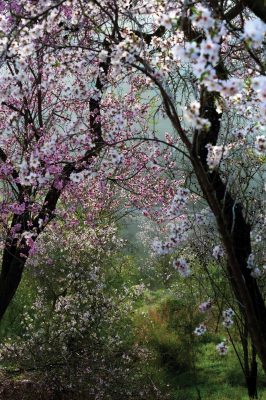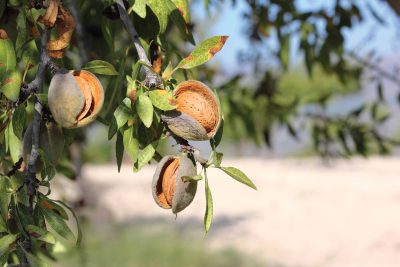×


We have detected your country as:
Please click here to go to the USA website or select another country from the dropdown list.
by: Janet Aslin, BFP Staff Writer
For lo, the winter is past, the rain is over and gone. The flowers appear on the earth; the time of singing has come. (Song of Songs 2:11–12a).
Is there anyone who does not long for the promise of spring during the dark and dreary days of winter? Here in Israel, the lovely almond blossoms herald the coming of that promise. Toward the end of January or early February, you may hear questions like, “Have you seen them yet?” or “I wonder when they will arrive?” All these questions point to one thing: almond blossoms.
 Native to the Land
Native to the LandThe almond is native to the Mediterranean region. In Israel, it can be found growing wild throughout the biblical heartland of Judea and Samaria as well as on the Golan Heights and in the Galilee region. A hardy tree, it manages well in areas with low precipitation.
The wild almond trees dotting Israel’s hillsides produce fragrant flowers that are primarily white with shades of pale pink. However, the fruit of these trees cannot be eaten as it contains a substance that produces poisonous cyanide. On the other hand, cultivated almonds—or sweet almonds—are found in groves and produce the tasty and nutritious nuts we enjoy so much.
Treasured in modern times, the almond is also woven into the history of the Jewish people. We know that almonds were a prized food in the Promised Land at the time Joseph was sold into slavery in Egypt. When Jacob prepared to send his sons to Egypt for a second time, he told them to take a gift to the “Egyptian” who held Benjamin captive. Among the items listed as the “best fruits of the land” (Gen. 43:11) was the almond.
Later in Jewish history, when Moses received detailed instructions for the construction of the Tabernacle and its contents, the construction of the menorah (seven-branched golden lampstand) featured almond flowers. The bowls for holding the oil were to “be made like almond blossoms, each with its ornamental knob and flower” (Exod. 25:34, emphasis added).
Another interesting appearance of the almond in Scripture is found in Numbers 17. After the rebellion of Korah and the plague that followed (Num. 16), the Lord instructed representatives from each of the twelve tribes to prepare a rod and write the name of that tribe’s leader on it. Aaron’s name was to be written for the tribe of Levi. The Lord planned to settle the disputes against Moses and Aaron as He demonstrated His chosen leaders when the rod of that man blossomed (Num. 17:5).
“Now it came to pass on the next day that Moses went into the tabernacle of witness, and behold, the rod of Aaron, of the house of Levi, had sprouted and put forth buds, had produced blossoms and yielded ripe almonds” (Num. 17:8). At the Lord’s command, this rod was then kept in the Tabernacle to be a sign to the rebels that the tribe of Levi were His chosen representatives (Num. 17:10).
 It may be splitting hairs, but almonds are not really nuts—they are drupes! There is a botanical difference between a nut, which is “a hard-shelled pod that contains both the fruit and seed of the plant” and a drupe. Composed of three layers, drupes “are actually fruit with a hard stony covering enclosing the seed.” Fellow drupes include pistachios, coconuts and cashews.
It may be splitting hairs, but almonds are not really nuts—they are drupes! There is a botanical difference between a nut, which is “a hard-shelled pod that contains both the fruit and seed of the plant” and a drupe. Composed of three layers, drupes “are actually fruit with a hard stony covering enclosing the seed.” Fellow drupes include pistachios, coconuts and cashews.
Almonds are also directly related to plums, nectarines, peaches, cherries and apricots. All are fruit produced by members of the prunus group of trees and shrubs.
According to Israel 21c, “While the United States produces the most almonds in the world, Israeli almonds are larger, tastier, and contain 10% more calcium than American and most other varieties.”
Almonds are a “nutritionally dense food,” providing many of the vitamins and minerals we need for health. Rich in antioxidants and one of the best sources for Vitamin E, almonds are also high in protein and fiber. According to Healthline, “the health benefits of almonds include lower blood sugar levels, reduced blood pressure and lower cholesterol levels. They can also reduce hunger and promote weight loss.”
As we anxiously await the first sighting of the almond blossoms, the early flowers are really just a small part of the richness that God has included in this tree. Not only does its beauty encourage us with the message that, “Yes, Spring is on its way,” but the fruit produced months later provides nutritional and medicinal benefits. What a wonderful gift from God!
Photo Credit: Click on photo to see photo credit
All logos and trademarks in this site are property of their respective owner. All other materials are property of Bridges for Peace. Copyright © 2024.
Website Site Design by J-Town Internet Services Ltd. - Based in Jerusalem and Serving the World.